Meet the artist who brought Pratchett's Discworld to life
Discover how he went from being a fan of the late author to a friend and long-term artistic collaborator.
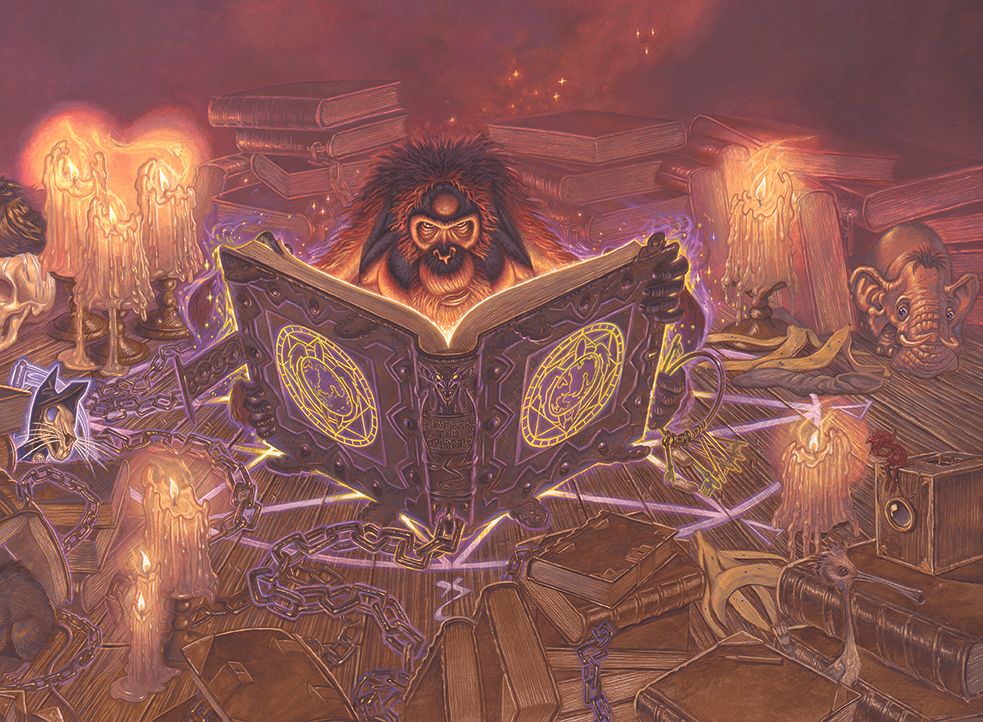
From making false teeth to firing flaming arrows and painting magic wossname for fantasy author Sir Terry Pratchett's Discworld books, British artist Paul Kidby has had long and eventful career, as he tells us.
Kidby grew up in suburban London in the 1960s and 70s. As a boy, there was a lady's house on his street that he found fascinating. In the window was a skeleton. And when he heard what this lady did for a living, he found her house all the more fascinating. But he was well into his teens before he dared knock on the door of Miss Ockingdon’s.
At that time, he’d just dropped out of sixth form and worked on a Youth Opportunity Program making false teeth. He’d been interested in art from a young age. He’d make plasticine models of the orcs and elves from the books that his big sister would read to him.
He was always drawing, too. He had plenty of supplies, since his dad was a stationary salesman. As a teenager, he drew imaginative pieces influenced by his two interests: fantasy literature and punk rock – The Lord of the Rings and The Jam, War of the Worlds and The Clash. Aged 17, Kidby “plucked up the courage” to introduce himself to Miss Ockingdon.
“Miss Ockingdon,” he says, “had been an anatomical artist working in operating theatres, and was an adept draughtswoman and calligrapher. She had taught art at Ealing Art College. Her students included Pete Townsend, Freddie Mercury and Ronnie Wood.
“She told me, in no uncertain terms, that if I was serious about becoming an artist, I had to learn the nuts and bolts of my craft, starting with perspective, anatomy and composition. I had to ditch my imaginative illustrations and start drawing from life.”
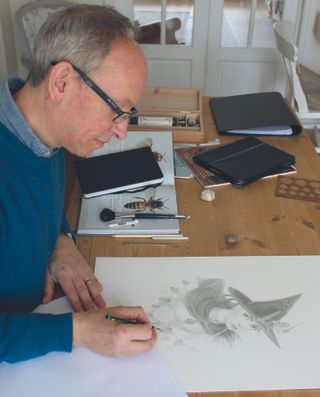
Kidby visited Miss Ockingdon every week. She critiqued his work and set him challenges. Technically, he learned a lot from her. But above all else he learned that to be a successful artist you need discipline. “It was the start,” the illustrator and sculptor says, “of a life-changing process in my artistic development.”
Get the Creative Bloq Newsletter
Daily design news, reviews, how-tos and more, as picked by the editors.
In the early 1980s, Kidby designed and painted roller blinds in a factory. He was working, but not hard. He and a friend would clock in and then go jogging. If they weren’t doing that, they were doing something far worse. “We made bows and arrows to fire across our department into the rolls of cardboard. This stopped after we got carried away and fired flaming arrows, as we realised things might be getting a tad out of hand.”
By the mid-80s, he was working as a commercial illustrator, first as a freelancer in London, where he created greetings cards and packaging, and later at Future Publishing in Bath (which publishes Imagine FX and Creative Bloq, among others), where he drew covers for magazines like Sega Power, GamesMaster, and Commodore Format.
“I had the optimism of youth,” he says, “but it did mean working a lot harder, including weekends. The days of firing arrows, flaming or otherwise, were well and truly over.”
"I had no idea how popular he was!"
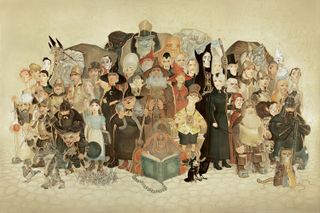
I shook his hand and gave him my envelope of sketches... a few weeks later, he rang me up and suggested that I create some artwork for him.
Paul Kidby
Kidby remembers the day that would define his career: his first meeting with best-selling author Sir Terry Pratchett.
“In 1993, my sister gave me The Colour of Magic by Terry Pratchett for my birthday. This was a pivotal gift,” he recalls. “At once, I was able to visualise Discworld and its inhabitants. I sketched up some of the characters and took them to a book signing in Bath.”
At the time, Kidby had no idea how popular the late author was and was rather surprised when he joined a very long queue to meet him. “I shook his hand and gave him my envelope of sketches. I expected to hear nothing further. However, a few weeks later, he rang me up and suggested that I create some artwork for him. It was a very exciting moment.”
Pratchett told him that the character designs he presented him with were the closest anyone had got to how he himself imagined them. “That for me was hugely encouraging, as was his endorsement of my creative work by allowing me to illustrate for him.
"I would visit him often at his home and we would discuss the character designs and develop the look of the environments. Terry’s work remains a great inspiration for me and my gratitude for the opportunity he gave me is huge.”
Depicting Discworld
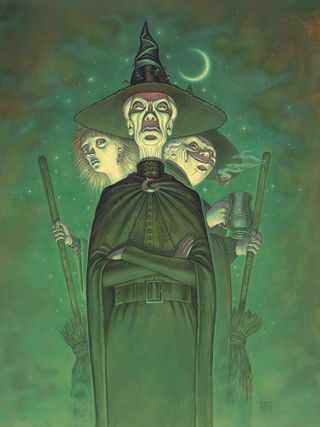
Since 2002, Kidby has designed book jackets for the author’s celebrated Discworld series and its various tie-ins. Kidby used to have direct contact with Sir Terry until the author’s death in 2015. They’d flesh out designs together. Now Discworld commissions come from publishers or the Pratchett estate.
For book jackets, Kidby receives a brief, then he works with an art editor until their ideas aline. “My job is to visualise the brief,” he says, “so it’s not a matter of compromise for me, rather a case of giving the client what they want to see. Sometimes I input additional ideas when I submit my designs, but it’s a collaborative process overall and one that I enjoy.”
Kidby begins by drawing a very rough sketch, which only he’ll ever see. He doesn’t develop it into a series of working sketches. Instead, once he has the idea straight, he starts work on what will eventually be the finished piece, adding lines, taking them out, working with the pencil and the eraser until he’s entirely happy with the composition. He shades for form and tone.
If he’s going to colour the work, he’ll create a detailed underpainting in sepia tones, which “provides the bones for the drawing by strengthening the lines and form.” He adds thin washes of colour.
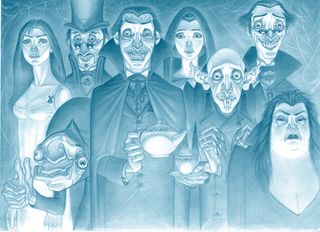
In the final stages, Kidby uses colour pencils for details and highlights. He describes himself as “modern old school.” He strives for accuracy, in perspective, in proportion, in the things that always underpin his paintings. He makes final tweaks in Photoshop. By his own admission, he’s not a fast worker.
“Even if the subject matter is fantastical,” he says, “such as a dragon, I’ll apply my knowledge of anatomy to make it believable. My work has a historical feel and my colours tend to be muted.
"I’ll often give an illustration a humorous slant, and sometimes I parody an existing painting, but only if it’s appropriate. I think the underlying thread that ties all my work together is ‘magical wossname’ – a useful Pratchett term.”
Kidby works every day, often including weekends. He wakes up a 6.30am and runs on the treadmill. He gets cracking no later than 9am, after breakfast and a strong pot of coffee. He stops for lunch, walks his dog in the afternoons, and does Pilates to “counteract the hours I spend hunched over my drawing table.” He’s usually done by 6pm and rarely works at night.
Kidby likes oils, acrylics or coloured pencils, and a smooth Bristol board on which to apply them. He doesn’t have a dedicated studio. He works at the dining table or in the conservatory. He uses an iPad, but for reference more than for making art. Other than that, he has no “fancy art equipment.”
Immortalised in bronze
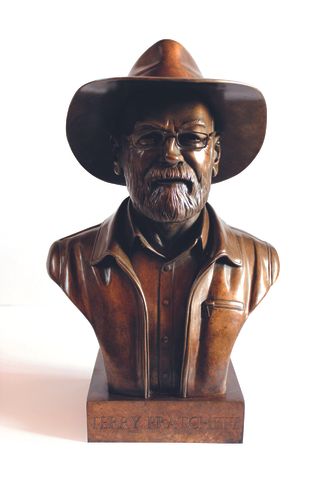
Kidby put together a project to honour the Discworld author, a sculpted portraiture bust of Sir Terry Pratchett. “I made it as a preliminary study for a full length, large-scale sculpture that I’ll be making of the writer for the city of Salisbury.”
The bust is made in the oil-based clay Chavant, Kidby explains. “It has no wire armature inside. Initially, I worked from photographs until I was happy with the basic proportions. I then began to work from memory to try and capture the expression of the man I knew. Only when I was satisfied that I had a likeness of Terry did I tackle his glasses and trademark hat.”
Kidby says that Pratchett’s signature glasses were very fiddly to make. “They’re formed with fine wire with a light skim of clay. The hat was made separately and can be removed. The sculpt was then taken to the foundry, Sculpture Castings in Basingstoke, where a team undertook the process of mould making and casting.
“The final stages are fettling the raw bronze, before applying the patination and a beeswax polish. There will be only 12 bronze casts.”
Interacting with viewers
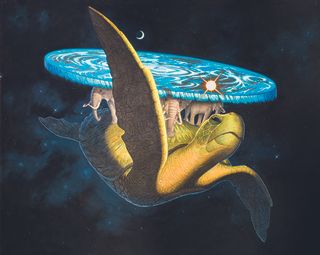
“As an illustrator,” Kidby says, “it’s my job to always consider my viewer and to convey information from the text into visual form.”
He finds exhibiting in galleries the most rewarding part of his job as it enables him to show work as he intended it to be seen, free of text, titles or changes made digitally by clients. It’s when he can interact directly with the viewer, the most intimate kind of artist-viewer communication.
Kidby is working in collaboration with Sir Terry Pratchett’s estate and the Salisbury Museum on a major exhibition titled Hisworld, which runs until January 2018 and features over 40 original Discworld paintings, including Kidby’s concept design for the large-scale bronze statue of Sir Terry for the city of Salisbury in England, where the author lived.
He has some new collaborations lined up, too: “Although Terry has sadly passed away,” Kidby says, “his ongoing legacy is extraordinary, and there’s still a wonderfully rich body of work for me to illustrate, so there are plenty of exciting new projects on the horizon.”
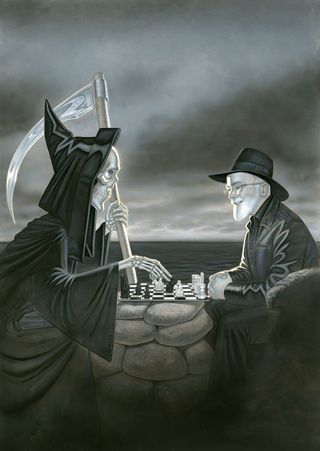
After two decades of these collaborations, Kidby’s art is almost inseparable from Pratchett’s writing, and vice versa. But being the go-to artist for one of the world’s most successful authors hasn’t changed the way he works. He sometimes spends years developing a piece before he puts pencil to paper. One single colour illustration can take six weeks to complete.
And it all goes back to the discipline that he learned from his time with Miss Ockingdon.
“I prefer to plough my own furrow,” he says, “and this doesn’t involve attending publishing parties, conventions, entering contests or being the focus of attention. So I guess courting praise is not important to me. In fact, the most important thing to me is to be left to get on with my work undisturbed.”
This article originally appeared in ImagineFX issue 151. Buy it here or subscribe here.
Read more:

Thank you for reading 5 articles this month* Join now for unlimited access
Enjoy your first month for just £1 / $1 / €1
*Read 5 free articles per month without a subscription

Join now for unlimited access
Try first month for just £1 / $1 / €1
Gary Evans is a journalist with a passion for creative writing. He's recently finished his Masters in creative writing, but when he's not hitting the books, he loves to explore the world of digital art and graphic design. He was previously staff writer on ImagineFX magazine in Bath, but now resides in Sunderland, where he muses on the latest tech and writes poetry.
